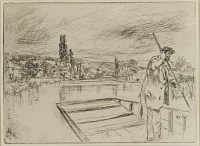Etchings Institutions search term: athenaeum
The Punt | ||
| Number: | 82 | |
| Date: | 1861 | |
| Medium: | etching and drypoint | |
| Size: | 120 x 166 mm | |
| Signed: | 'Whistler' at lower left (1-3); 'W' partly removed (4-final) | |
| Inscribed: | '1861.' at lower left (1-3); partly removed (4-final) | |
| Set/Publication: | Junior Etching Club, 1862 | |
| No. of States: | 6 | |
| Known impressions: | 35 | |
| Catalogues: | K.85; M.86; T.85; W.68 | |
| Impressions taken from this plate (35) | ||
KEYWORD
TITLE
'The Angler' (1862, Passages from Modern English Poets). 1
'The Punt' (1874, Ralph Thomas, Jr (1840-1876)). 2
'The Punt' (1881, Union League Club). 3
'The Punt' (1886, Frederick Wedmore (1844-1921)). 4
This is an odd situation: the original title is based on J.H. Reynold's poem, 'The Angler's Soliloquy', which Whistler supposedly illustrated, but the etching is dominated completely by a punt. Not surprisingly, later cataloguers opted for the descriptive title, 'The Punt', as does this catalogue.
1: Illustration to J.H. Reynolds's 'The Angler's Soliloquy', Passages from Modern English Poets, London, [1862].
2: Thomas 1874 (cat. no. 85).
3: New York 1881 (cat. no. 96).
4: Wedmore 1886 A (cat. no. 68).
DESCRIPTION
SITTER
SITE
5: Mansfield 1909 (cat. no. 85).
6: Lochnan 1984 , chap. 7, n. 15.
DISCUSSION
7: See George D. Leslie, RA, Our River, London, 1881, pp. 222-41.


